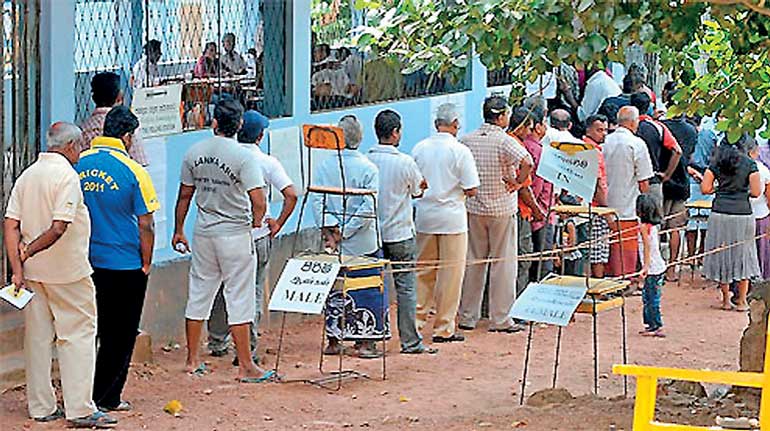Monday Mar 03, 2025
Monday Mar 03, 2025
Friday, 9 September 2016 00:01 - - {{hitsCtrl.values.hits}}
 Electoral reform is not a panacea, but merely one of many steps required in addressing public concerns of declining political standards
Electoral reform is not a panacea, but merely one of many steps required in addressing public concerns of declining political standards
By Asoka Obeyesekere
The fact that proposing a new electoral system is a responsibility placed upon the main 21-member steering committee of the Constitutional Assembly underscores its importance.
The committee must address three key questions Q1: What principles must a new electoral system champion? Q2: Which electoral system can deliver these principles? Q3: What issues can an electoral system not solve?
I will show that the core principle that Government is mandated to deliver is a return to localised constituency representation, coupled with the need for a proportionate result. The only way to suitably deliver this balance is through a dual ballot Mixed Member Proportional (MMP) electoral system. I will conclude in emphasising that despite electoral reforms, many of its perceived cures will not be delivered through electoral reform alone.
What principles must a new electoral system champion?
At the heart of the electoral reform debate is the pledge by President Maithripala Sirisena to introduce a “Mixed Electoral System that ensures representation of individual Members for Parliamentary Constituencies, with mechanisms for proportionality”.
There are therefore two key principles underscoring this pledge.
Firstly, having an individual MP improves the quality of representative and representation, as the candidate has a smaller area to campaign and represent, thereby ensuring lower campaign costs (an assumption which I go on to show is often mistaken) and greater local focus.
Secondly, in reinforcing the principle of proportionality, the concept of fairness is preserved, as smaller parties, which are unlikely to win individual constituencies, can still garner support across broader geographic areas.
Which electoral system can deliver these principles?
There is only one mixed electoral system that can provide constituency representation whilst guaranteeing a proportionate (or at worst a very close to proportionate) overall outcome. This system is called Mixed Member Proportional (MMP) and every single MMP in national parliaments across the world have a dual vote.
A dual vote MMP delivers the combination of constituency representation and proportionate results by allowing voters to exercise greater choice. In addition to voting for a candidate, a citizen also gets to vote for a party. Both choices need not conform with one another. You can therefore exercise your vote for a SLFP candidate in a constituency and then vote for the JVP as a party.
The important point is that the final composition of parliament is determined by the latter party vote and separate list (PR) seats are used to top up any party which hasn’t achieved their vote share through constituency seats alone.
What issues can an electoral system not solve?
There are two key areas beyond the scope of electoral reform. Firstly, underpinning the principle of constituency representation was a feeling that a new electoral system will reduce campaign costs. Many hark back to 1977 when Felix Dias Bandaranaike, a goliath of his time was defeated in Dompe by Sarathchandra Rajakaruna who conducted a localised door-to-door campaign.
Whilst this opportunity could arise, in reality campaign costs could further spiral as individuals must win in their constituencies. Similar sums of money employed in past elections could therefore be used in more focussed efforts at a constituency level to increase the instances of vote buying. This issue needs the implementation of campaign finance regulations, not electoral reforms.
Secondly, an electoral system cannot reduce election violence. Whilst instances of intra-party violence will reduce with the absence of manape (preferential vote) canvassing, the new fault line will be cross-party which could prove ever more combustible. Election violence is a law and order ailment and prescribing electoral reform is a misdiagnosis.
Going forward
Transparency International Sri Lanka has provided an electoral reform brief to all members of the steering committee on the need for a dual vote MMP electoral system.
In the event that the committee does not provide a dual vote MMP, the committee members must justify how the pledge to deliver a balance of constituency representation with proportionate outcomes can be otherwise achieved.
Similarly, the preamble of the proposals must be honest in acknowledging that electoral reform is not a panacea, but merely one of many steps required in addressing public concerns of declining political standards.
(The writer is Executive Director of Transparency International Sri Lanka.)
Discover Kapruka, the leading online shopping platform in Sri Lanka, where you can conveniently send Gifts and Flowers to your loved ones for any event including Valentine ’s Day. Explore a wide range of popular Shopping Categories on Kapruka, including Toys, Groceries, Electronics, Birthday Cakes, Fruits, Chocolates, Flower Bouquets, Clothing, Watches, Lingerie, Gift Sets and Jewellery. Also if you’re interested in selling with Kapruka, Partner Central by Kapruka is the best solution to start with. Moreover, through Kapruka Global Shop, you can also enjoy the convenience of purchasing products from renowned platforms like Amazon and eBay and have them delivered to Sri Lanka.
Discover Kapruka, the leading online shopping platform in Sri Lanka, where you can conveniently send Gifts and Flowers to your loved ones for any event including Valentine ’s Day. Explore a wide range of popular Shopping Categories on Kapruka, including Toys, Groceries, Electronics, Birthday Cakes, Fruits, Chocolates, Flower Bouquets, Clothing, Watches, Lingerie, Gift Sets and Jewellery. Also if you’re interested in selling with Kapruka, Partner Central by Kapruka is the best solution to start with. Moreover, through Kapruka Global Shop, you can also enjoy the convenience of purchasing products from renowned platforms like Amazon and eBay and have them delivered to Sri Lanka.